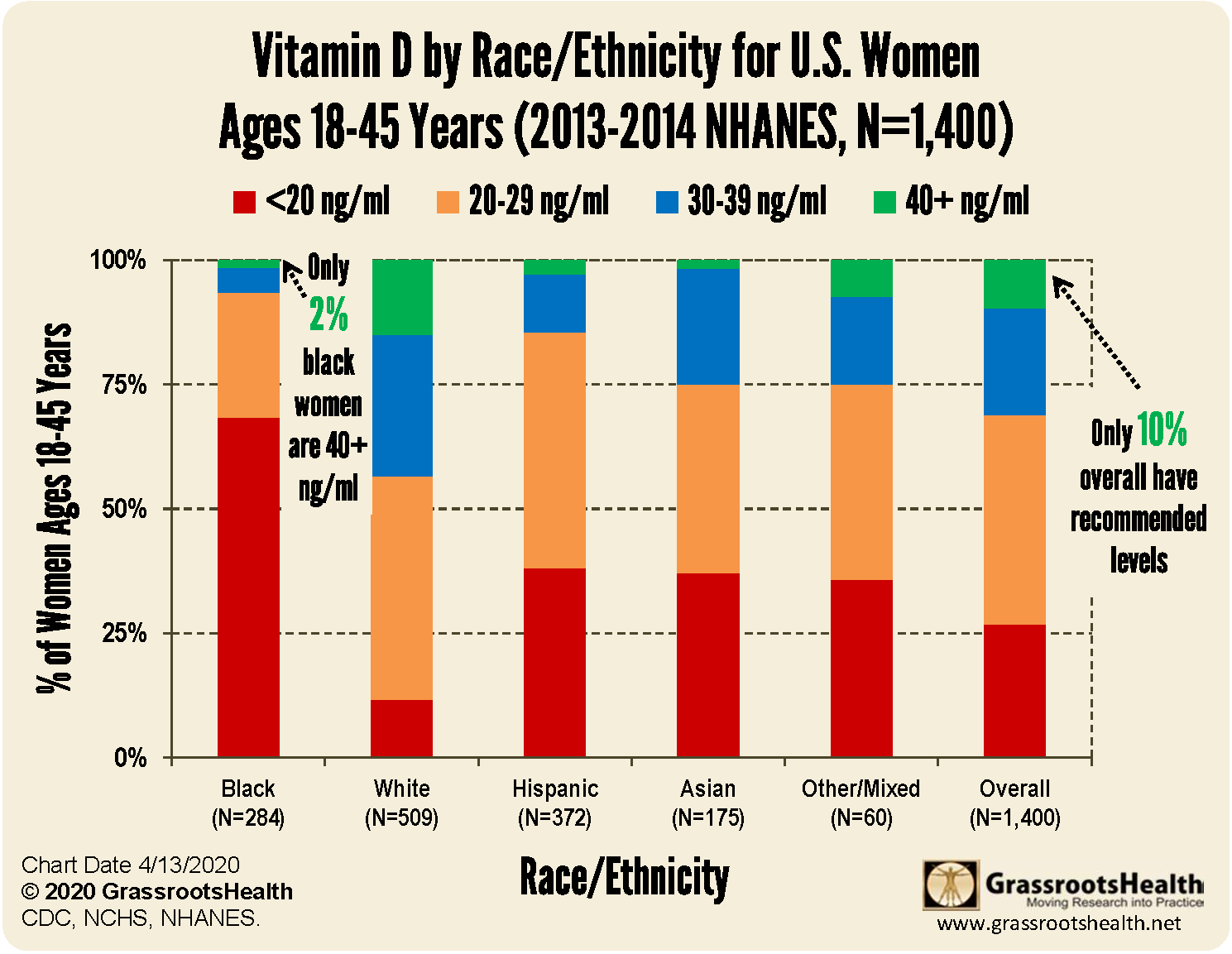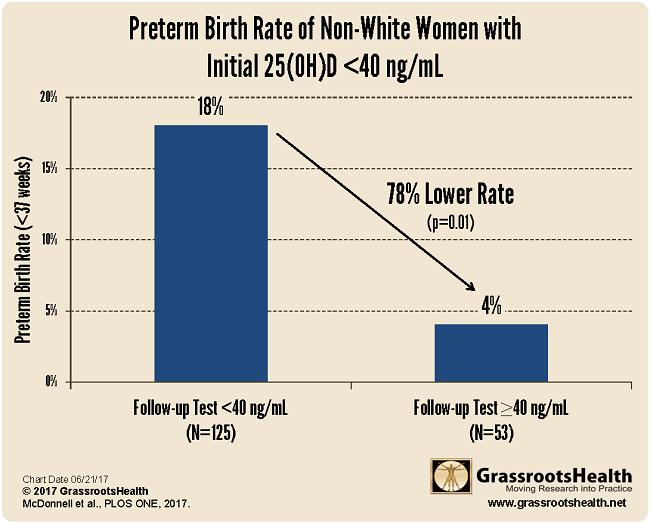Published on April 17, 2020
In our last post, we began the discussion about racial disparities in health, specifically that some of the same health problems that are more prevalent among blacks are also associated with vitamin D deficiency. Today, we will review some of our own research showing the gap in preterm birth outcomes between white and black mothers – a gap that virtually disappears when vitamin D deficiency is corrected.
GrassrootsHealth Research on Preterm Birth
 GrassrootsHealth worked with a group of vitamin D researchers to analyze data on preterm birth from two vitamin D supplementation randomized controlled trials (RCTs), 509 women total. The RCTs recorded vitamin D levels from the first OB visit to the last, and divided participants into groups who received either 400 IU, 2000 IU, or 4000 IU/day. The population was 74% Hispanic or black, with a starting average vitamin D level of 23 ng/ml (57 nmol/L). The black women started with a median vitamin D level of 16 ng/ml (40 nmol/L), and achieved a median level of 30 ng/ml (75 nmol/L) by the end. Note that this and other research has found that preterm birth reduction is greatest by getting mothers over 40 ng/ml (100 nmol/L) and 16 ng/ml is definitely less than that.
GrassrootsHealth worked with a group of vitamin D researchers to analyze data on preterm birth from two vitamin D supplementation randomized controlled trials (RCTs), 509 women total. The RCTs recorded vitamin D levels from the first OB visit to the last, and divided participants into groups who received either 400 IU, 2000 IU, or 4000 IU/day. The population was 74% Hispanic or black, with a starting average vitamin D level of 23 ng/ml (57 nmol/L). The black women started with a median vitamin D level of 16 ng/ml (40 nmol/L), and achieved a median level of 30 ng/ml (75 nmol/L) by the end. Note that this and other research has found that preterm birth reduction is greatest by getting mothers over 40 ng/ml (100 nmol/L) and 16 ng/ml is definitely less than that.
But the most telling part of this analysis comes toward the end of the results section of the paper
Differences by race/ethnicity were not statistically significant when 25(OH)D concentration was included as a covariate in multivariable regression analysis.
What Does This Mean?
When statisticians crunch data, to sort out findings from a study, there are times when they want to make sure that the finding wasn’t due to a separate variable. For example, many times in vitamin D trials, they account for BMI, which is used as a marker for obesity.
Multivariable regression testing is a way to look at many variables within your trial and see how they affect each other. So, in the BMI example, did vitamin D lower all heart disease? Or only for those that had a BMI < 25? We won’t get into the math to make this computation happen, let’s just say the statisticians know their numbers.
So, the statement above is really the key to disparity and the plausible conclusion that vitamin D levels in recommended ranges (40-60 ng/ml) could level the playing field.
To a statistician this statement means…
there was NO difference in preterm birth rates (what was measured in the study) by ethnicity if vitamin D levels were equal.
Now, we KNOW that there is a huge disparity in preterm birth rates among racial groups. And, as you can now see, we can erase disparity in preterm birth caused by vitamin D deficiency, according to this analysis, by bringing everyone’s vitamin D levels to at least 40 ng/ml.
One More Validation of Reduction in Preterms by Vitamin D, Published in 2017.
It is urgent to take action here–there has been no change in the incidence of preterm rates in 10 years. What needs to be done?
The latest GrassrootsHealth paper on preterm birth outcomes over two years at the Medical University of South Carolina also has a few things to say about disparity. Over the two-year study period, 1,064 women were monitored, of which 46% were white, 37% black, and 11% Hispanic. Let’s see if we work our way backwards – if we get an expected outcome. Meaning, we know, by NHANES, what the average vitamin D level is by racial group. Let’s use this table from the paper to see if we can approximate what the average preterm birth rate is for each group (before treatment).
We happen to have a NHANES chart for women of childbearing age.
According to NHANES data…
68% of black women (which would equate to 268 women in the study) would have vitamin D levels below 20 ng/ml and would be expected to have a 20% preterm birth rate. That is 54 preterm babies. 30% of black women (118 women in the study) would have levels between 20-39 ng/ml with a 12.5% preterm birth rate, which would be 15 preterm babies. Using this math we would have had, without treatment, 69 preterm babies out of 395 black women, or 17%. Page 6 of the paper reports that black women entered the study with a 19% preterm birth rate – close to the same number (17%).
What did the study find?
Analyzing the non-white women (black, Hispanic, other) who went through the study, had more than one vitamin D test, and by time of delivery had raised their levels above 40 ng/ml, revealed that those women had a scant 4% preterm birth rate – almost unheard of in any OB circle. By comparison, those who had not achieved a level of at least 40 ng/ml by their final vitamin D test prior to delivery had a preterm birth rate of 18%.
One Simple Change Makes a BIG Difference
After reading information from this and our last post, it should be clear that vitamin D alone has the potential to make a big difference in health outcomes for black individuals. But why are blacks so deficient in vitamin D in the first place? Our final post of this series will answer that question. Stay tuned!
Could You or Someone You Know Need More Vitamin D?
We’re in a time of great crisis that could be greatly affected by making sure you and everyone you know has a serum level of at least 40 ng/ml. Help us help you.
Do you know what your vitamin D level is? Be sure to test today to find out, and take steps to keep it within a target of 40-60 ng/ml or 100-150 nmol/L! Give your immune system the nutrients it needs to support a healthy you and protect yourself from unnecessary diseases.
Through GrassrootsHealth Nutrient Research Institute, you can also test your essential elements magnesium, copper, zinc and selenium, toxins such as lead, mercury and cadmium, as well as your omega-3 levels, inflammation levels and thyroid stimulating hormone (TSH) level. Find out your levels today! Log on to the test selection page (click the link below) to get your tests and see for yourself if your levels can be improved.
Make sure you track your results before and after, about every 6 months!
How can I track my nutrient intake and levels over time?
To help you track your supplement use and nutrient levels, GrassrootsHealth has created the Personal Health Nutrient Decision System called
For each specific supplement, you can track what days you take it, how much, and many other details. This will help you know your true supplemental intake and what patterns of use work for you to reach and maintain optimum nutrient levels. Check it out today!










